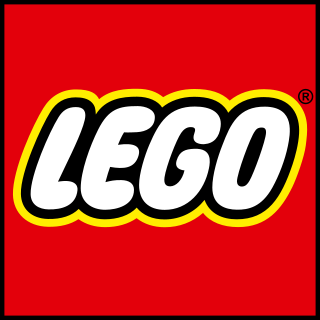
Lego is a line of plastic construction toys manufactured by the Lego Group, a privately held company based in Billund, Denmark. Lego consists of variously coloured interlocking plastic bricks made of acrylonitrile butadiene styrene (ABS) that accompany an array of gears, figurines called minifigures, and various other parts. Its pieces can be assembled and connected in many ways to construct objects, including vehicles, buildings, and working robots. Assembled Lego models can be taken apart, and their pieces can be reused to create new constructions.
Meccano is a brand of model construction system created in 1898 by Frank Hornby in Liverpool, England. The system consists of reusable metal strips, plates, angle girders, wheels, axles and gears, and plastic parts that are connected using nuts and bolts. It enables the building of working models and mechanical devices.

Lego Mindstorms is a discontinued line of educational kits for building programmable robots based on Lego bricks.
Lego Technic is a line of Lego interconnecting plastic rods and parts. The purpose of this series is to create advanced models of working vehicles and machines, compared to the simpler brick-building properties of normal Lego.

A scale model is a physical model which is geometrically similar to an object. Scale models are generally smaller than large prototypes such as vehicles, buildings, or people; but may be larger than small prototypes such as anatomical structures or subatomic particles. Models built to the same scale as the prototype are called mockups.

Heathkit is the brand name of kits and other electronic products produced and marketed by the Heath Company. The products over the decades have included electronic test equipment, high fidelity home audio equipment, television receivers, amateur radio equipment, robots, electronic ignition conversion modules for early model cars with point style ignitions, and the influential Heath H-8, H-89, and H-11 hobbyist computers, which were sold in kit form for assembly by the purchaser.
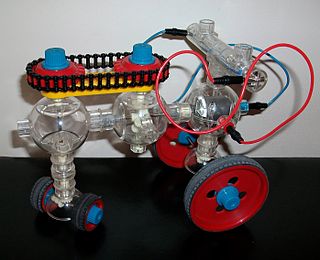
Capsela is a construction toy brand consisting primarily of gears and motors in spherical plastic capsules that can be connected to form various static or dynamic toys suitable for land or water. The capsules typically have six hollow octagonal connectors protruding, where an octagonal sleeve piece bridges between two capsules. The hollow connection pegs on a capsule can have electrical or rotary adapters inside, reaching into the next capsule. There are electric motor capsules, gear capsules, switch capsules, pontoon capsules, and others; there are also battery holders, wheels, propellers, impellers, lights, wires, and miscellaneous supporting pieces.
Tyco Toys was an American toy manufacturer. It was acquired by Mattel in 1997, becoming one of its brands.
The history of Lego began in 1932 in the carpentry workshop of Ole Kirk Christiansen, a Danish carpenter who initially produced furniture but later started making wooden toys. The company was named "Lego" in 1934, a contraction from the Danish phrase "leg godt", meaning "play well".

Lego Trains is a product range and theme of the construction toy Lego, which incorporates buildable train sets. The Lego Trains theme became a sub-theme of Lego City in 2006. Products in the range have included locomotives, tracks, rolling stock, stations, signal boxes, and other track-side buildings and accessories. The theme is popular among adult fans, as well as children, and has spawned international associations and conventions. The train system is sometimes referred to as 'L-gauge' among Lego fans, in reference to traditional model railway scales. Lego trains use a nominal gauge of 37.5 mm, based on 5-stud track centerlines gauge, corresponding with a circa 1:38 scale.

An electronic kit is a package of electrical components used to build an electronic device. Generally, kits are composed of electronic components, a circuit diagram (schematic), assembly instructions, and often a printed circuit board (PCB) or another type of prototyping board.
1:48 scale is a scale commonly used in diecast models, plastic models made from kits, and construction toys. It is especially popular with manufacturers of model aircraft and model trains, where it is known as "O scale". 1:48 is also a popular scale among Lego enthusiasts, since it is approximately the scale of the Lego minifigure.
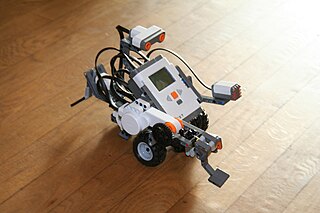
Lego Mindstorms NXT is a programmable robotics kit released by Lego on August 2, 2006. It replaced the Robotics Invention System, the first-generation Lego Mindstorms kit. The base kit ships in two versions: the retail version and the education base set. It comes with the NXT-G programming software or the optional LabVIEW for Lego Mindstorms. A variety of unofficial languages exist, such as NXC, NBC, leJOS NXJ, and RobotC. A second-generation set, Lego Mindstorms NXT 2.0, was released on August 1, 2009, with a color sensor and other upgrades. The third-generation EV3 was released in September 2013.
Built to Rule was a building block toyline from Hasbro released from 2003 to 2005. The sets included block that are compatible with such leading brands as Lego. These sets were Sets are usually based upon existing toys and characters from the Hasbro brand, such as Tonka, G.I. Joe and Transformers: Armada.

Tente is a line of construction toys created in 1972 by EXIN-LINES BROS S.A., a plastics and toy company based in Barcelona, Spain which ceased operation in 1993. The toys consist of multi-colored interlocking plastic bricks in multiple scales and an accompanying array of wheels, minifigures, and various accessories.

Lego Design byME was a service connected with the construction toy Lego. Using this service, people could design their own Lego models using a computer program, then upload them to the Lego website, design their own box design, and order them for actual delivery. The brand also covered a small selection of products that have been designed by Lego fans, and which were available to purchase as a set.

Educational toys are objects of play, generally designed for children, which are expected to stimulate learning. They are often intended to meet an educational purpose such as helping a child develop a particular skill or teaching a child about a particular subject. They often simplify, miniaturize, or even model activities and objects used by adults.
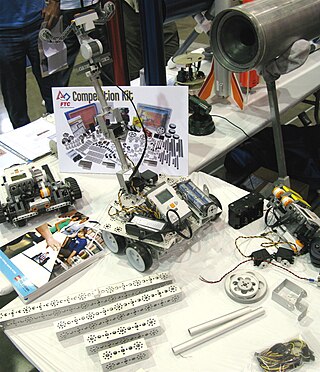
TETRIX Robotics consists of two robotic kits by Pitsco Education. The two sets are the TETRIX MAX building system and the TETRIX PRIME building system. They are intended to be used as educational robotics and for competitions such as the FIRST Tech Challenge.
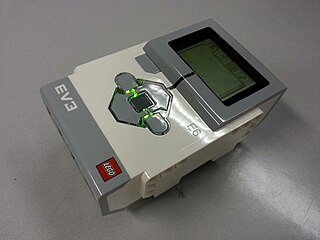
LEGO Mindstorms EV3 is the third generation robotics kit in LEGO's Mindstorms line. It is the successor to the second generation LEGO Mindstorms NXT kit. The "EV" designation refers to the "evolution" of the Mindstorms product line. "3" refers to the fact that it is the third generation of computer modules - first was the RCX and the second is the NXT. It was officially announced on January 4, 2013, and was released in stores on September 1, 2013. The education edition was released on August 1, 2013. There are many competitions using this set, including the FIRST LEGO League Challenge and the World Robot Olympiad, sponsored by LEGO.















